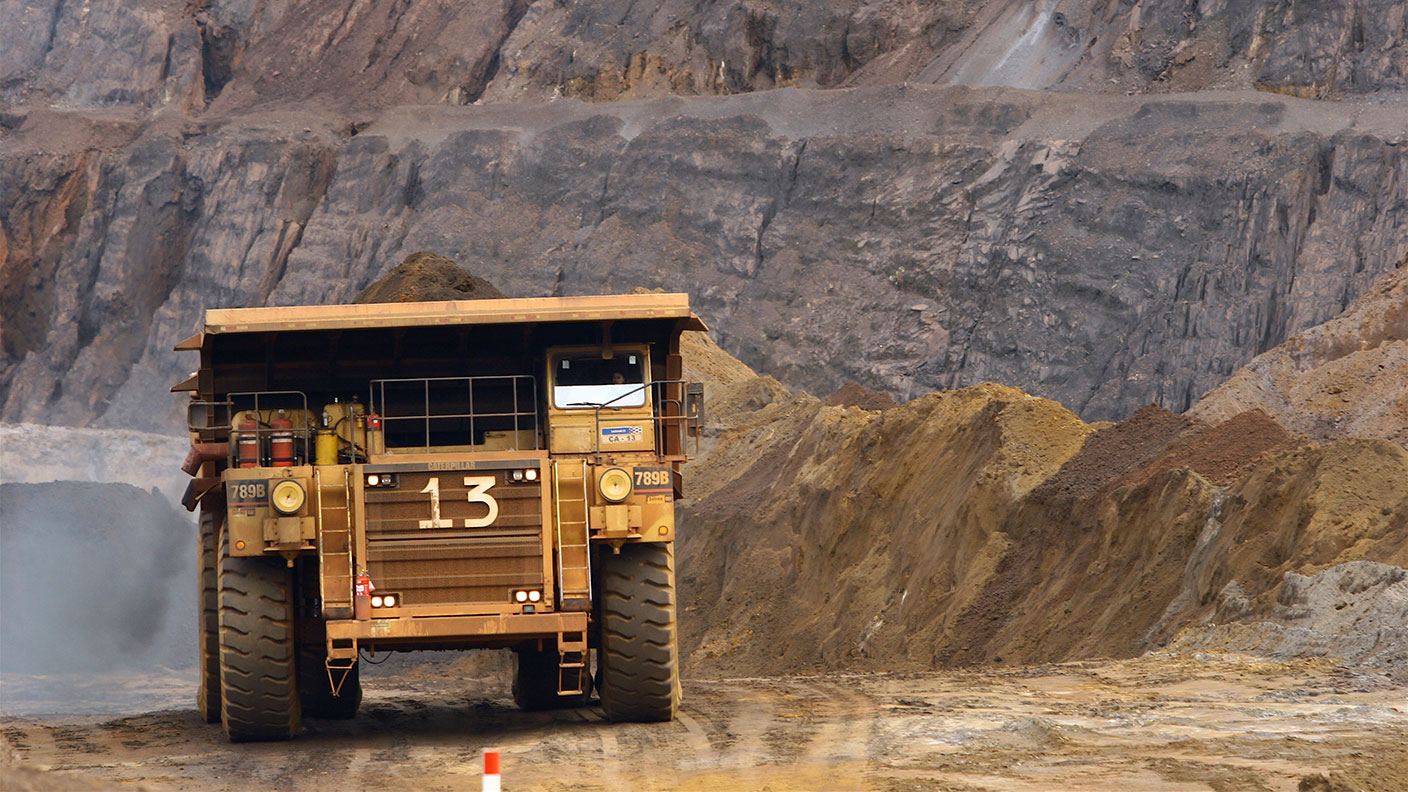Mining stocks have been great investments this year – but is it time to sell?
Markets have not had a good start to 2022 – with the exception of mining stocks. John Stepek asks if the sector has further to go, or if you should take profits while the going is good.


Before I get started this morning, I wanted to alert you to an extra bit of quality reading material for your weekend.
In association with Templeton Emerging Markets investment trust, we’ve put together a special report on the 2022 outlook for emerging markets.
MoneyWeek subscribers will be getting a print copy with this week’s issue, but if you can’t wait until the postie arrives, or you aren’t yet a subscriber (six issues for free right here, sign up now, nudge nudge) then you can read the digital version for free, right here on the MoneyWeek website.
MoneyWeek
Subscribe to MoneyWeek today and get your first six magazine issues absolutely FREE

Sign up to Money Morning
Don't miss the latest investment and personal finances news, market analysis, plus money-saving tips with our free twice-daily newsletter
Don't miss the latest investment and personal finances news, market analysis, plus money-saving tips with our free twice-daily newsletter
Hope you enjoy it!
Now, over to this morning’s newsletter – a look at mining stocks.
Is the mining sector near a top – or only getting started?
Markets in general have not had a good start to 2022. One glaring exception to this is the mining sector.
Things were looking up for commodities producers in general. There was already talk of a new supercycle. Then the war in Ukraine sent the price of everything soaring, as the market for raw materials split into “non-Russian stuff” and “Russian stuff”, with the latter now only touchable with a non-US approved ten-foot bargepole.
One investment trust that we’ve been flagging up to readers as a good way to play the sector is BlackRock World Mining Trust (LSE: BRWM). It’s had a very good start to 2022 – the share price is up by nearly 30% in the year to date.
That’s a substantial gain. Moreover, the share price is now close to its 2011 record. That’s not necessarily relevant – its valuation then was different to today’s – but it’s the sort of yardstick that makes some investors nervous.
And moreover again, this is a cyclical sector. Like it or not, mining is volatile; buy and hold forever is a nice idea but it’s not the optimum way to invest in this sector.
So is it time to get out while the going is good? MoneyWeek columnist Max King reckons – in his typically contrarian manner – that investors in mining stocks need to be cautious, and indeed that holders “should look for the chance to exit”.
I have to say, I’m a bit more relaxed than Max (which is not to say that I’m right). From a big picture perspective, the future of the commodities market is very unclear right now.
Putting aside the whole question of whether we’re starting another supercycle for the moment (most mining people will tell you that we are but that’s like asking estate agents about house prices), the change to the market structure is also significant.
If we face a permanently bifurcated market (resources that the Western world can buy, versus resources that only companies willing to ignore Western sanctions can buy) then that implies higher base level prices because you have a smaller market to shop in.
(Think of it like this – if half the British population was only allowed to shop in Tesco and the other half was only allowed to shop in Sainsbury’s, would that drive grocery prices overall higher or lower? Exactly.)
In short, I’d hang onto the investment trust. It’s a solid one-stop shop for the mining sector, and you’re getting a 5%-plus dividend (for now, though this may fall in the future of course). If you feel concerned, the key is to “rebalance” – look at how much of your portfolio is allocated to miners or resources, then sell down to where you feel more comfortable.
Gold miners might be a better bet for the adventurous
That said, if you’re looking for a sector that might have more potential for bigger gains, then I’d have to point to the gold miners.
For example, the VanEck Gold Miners ETF (the one that tracks the performance of the biggest listed gold miners) peaked at more than $60 a share in 2011. Currently it’s on less than $40 a share.
I’d make a couple of points on that. Firstly, gold miners were not the best way to play the gold boom of the noughties. Long story short, that’s because they had no capital discipline. They took money in and they spent it like drunken sailors. You’d have been as well to own a plain old gold bar.
That’s changed. Like most of the resources sector, including fracking companies, gold miners have been chastened by a prolonged bear market and by being treated as toxic investments by prospective shareholders. So relative to the price of gold, I think it’s a reasonable hypothesis that they’d outperform once investors start to wake up to their change of attitude.
Secondly, relative to the price of gold, big gold miners still look cheap. Indeed, right now, they’re only a little more expensive relative to gold than they were back in 2000. That probably reflects this lack of confidence. When will that change? I don’t know. But it strikes me that it’s worth having exposure for when it does.
Get the latest financial news, insights and expert analysis from our award-winning MoneyWeek team, to help you understand what really matters when it comes to your finances.
John Stepek is a senior reporter at Bloomberg News and a former editor of MoneyWeek magazine. He graduated from Strathclyde University with a degree in psychology in 1996 and has always been fascinated by the gap between the way the market works in theory and the way it works in practice, and by how our deep-rooted instincts work against our best interests as investors.
He started out in journalism by writing articles about the specific business challenges facing family firms. In 2003, he took a job on the finance desk of Teletext, where he spent two years covering the markets and breaking financial news.
His work has been published in Families in Business, Shares magazine, Spear's Magazine, The Sunday Times, and The Spectator among others. He has also appeared as an expert commentator on BBC Radio 4's Today programme, BBC Radio Scotland, Newsnight, Daily Politics and Bloomberg. His first book, on contrarian investing, The Sceptical Investor, was released in March 2019. You can follow John on Twitter at @john_stepek.
-
 The most influential people of 2025
The most influential people of 2025Here are the most influential people of 2025, from New York's mayor-elect Zohran Mamdani to Japan’s Iron Lady Sanae Takaichi
-
 Millions of parents are missing out on up to £720 a year in extra pension cash – are you affected?
Millions of parents are missing out on up to £720 a year in extra pension cash – are you affected?A mum who narrowly missed out on the pension boost said she “never knew the government rule existed” and wants other parents to use it
-
 Halifax: House price slump continues as prices slide for the sixth consecutive month
Halifax: House price slump continues as prices slide for the sixth consecutive monthUK house prices fell again in September as buyers returned, but the slowdown was not as fast as anticipated, latest Halifax data shows. Where are house prices falling the most?
-
 Rents hit a record high - but is the opportunity for buy-to-let investors still strong?
Rents hit a record high - but is the opportunity for buy-to-let investors still strong?UK rent prices have hit a record high with the average hitting over £1,200 a month says Rightmove. Are there still opportunities in buy-to-let?
-
 Pension savers turn to gold investments
Pension savers turn to gold investmentsInvestors are racing to buy gold to protect their pensions from a stock market correction and high inflation, experts say
-
 Where to find the best returns from student accommodation
Where to find the best returns from student accommodationStudent accommodation can be a lucrative investment if you know where to look.
-
 The world’s best bargain stocks
The world’s best bargain stocksSearching for bargain stocks with Alec Cutler of the Orbis Global Balanced Fund, who tells Andrew Van Sickle which sectors are being overlooked.
-
 Revealed: the cheapest cities to own a home in Britain
Revealed: the cheapest cities to own a home in BritainNew research reveals the cheapest cities to own a home, taking account of mortgage payments, utility bills and council tax
-
 UK recession: How to protect your portfolio
UK recession: How to protect your portfolioAs the UK recession is confirmed, we look at ways to protect your wealth.
-
 Buy-to-let returns fall 59% amid higher mortgage rates
Buy-to-let returns fall 59% amid higher mortgage ratesBuy-to-let returns are slumping as the cost of borrowing spirals.
